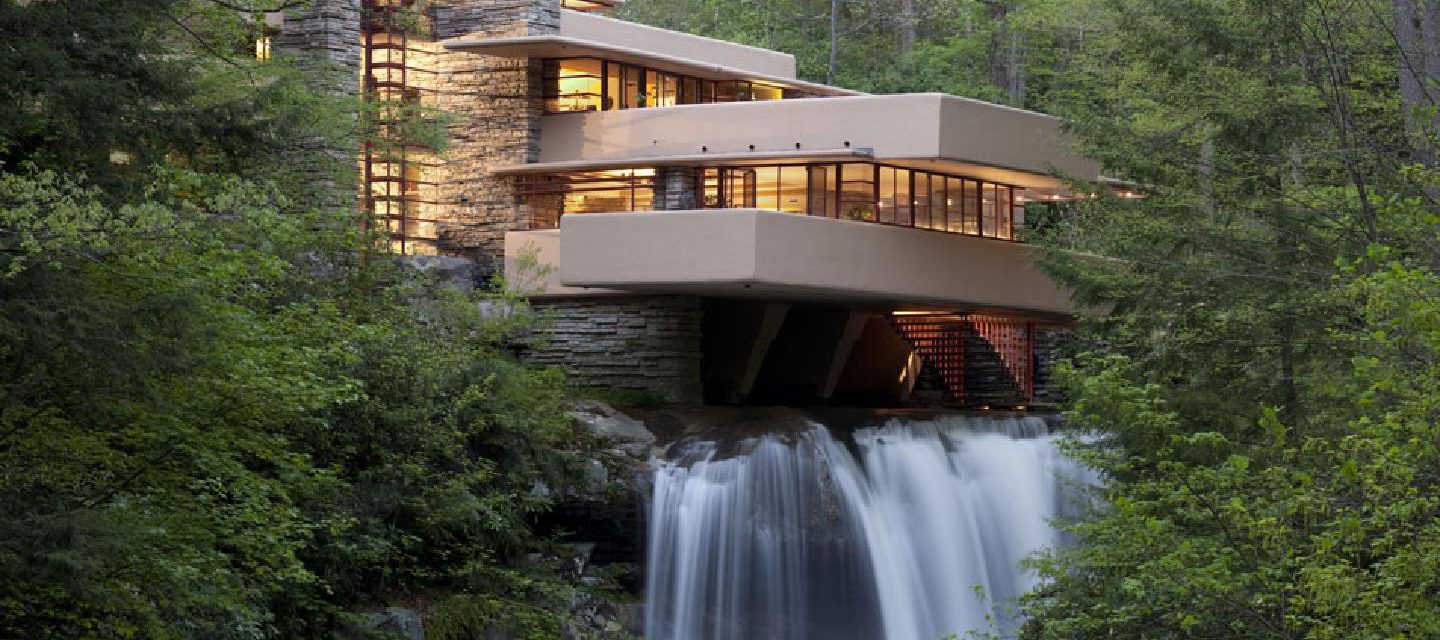Home > Famous Houses in United States > Fallingwater House
Fallingwater House

Fallingwater: A Masterpiece of Architecture and Natural Harmony
Introduction:
Fallingwater, also known as the Kaufmann Residence, is an architectural gem located in southwestern Pennsylvania, USA. Designed by the legendary American architect Frank Lloyd Wright, it is considered one of the most iconic and influential buildings of the 20th century. This essay will delve into the history, design, significance, and enduring legacy of Fallingwater, exploring its unique integration with nature and its impact on architectural discourse.
Historical Context:
Fallingwater was commissioned by Edgar J. Kaufmann, a prominent Pittsburgh businessman and department store owner, and his wife, Liliane, in 1935. They sought a weekend retreat away from the bustling city, surrounded by the serene beauty of the natural landscape. The Kaufmanns had initially requested a house near the top of Bear Run, a waterfall on their property. However, Wright proposed an audacious plan to build the house directly over the waterfall, incorporating its dynamic elements into the design.
Design and Construction:
Construction of Fallingwater began in 1936 and was completed in 1939. Wright, renowned for his organic architecture philosophy, aimed to create a harmonious union between the built environment and nature. He sought to blur the boundaries between interior and exterior spaces, seamlessly integrating the house with its surroundings. The house consists of a series of cantilevered terraces, balconies, and concrete platforms that extend towards and over the waterfall. The main living areas feature floor-to-ceiling windows, allowing the residents to enjoy breathtaking views of the surrounding forest and cascading water. Large natural rock formations were incorporated into the interior, further emphasizing the connection to the landscape.
Key Features and Design Principles:
a. Integration with Nature: Fallingwater epitomizes Wright's principle of organic architecture, seamlessly blending with its natural surroundings. The cantilevered design, with its dramatic overhangs, reflects the rock ledges and horizontal lines found in the landscape.
b. Use of Materials: Wright employed locally sourced materials, such as sandstone quarried from the site, reinforced concrete, and steel, to create a structure that harmonized with the environment. These materials not only enhanced the visual appeal but also ensured durability and stability.
c. Unity of Space: Fallingwater features an open floor plan that flows seamlessly from room to room, enhancing the sense of unity and interconnectedness. The interior spaces are designed to be functional, comfortable, and aesthetically pleasing.
d. Relationship with Water: The house's most distinctive feature is its direct connection to the waterfall. The sound of rushing water permeates the living spaces, creating a tranquil and immersive experience.
Significance and Impact:
Fallingwater has had a profound impact on the field of architecture and continues to inspire generations of designers. Its revolutionary design challenged traditional notions of building and showcased the possibilities of harmonizing human-made structures with the natural environment.
a. Organic Architecture: Fallingwater is widely regarded as a masterpiece of organic architecture, embodying Wright's philosophy that buildings should be in harmony with nature. It influenced subsequent architectural movements that prioritized environmental integration and sustainable design
b. Spatial Innovation: The open-plan layout and seamless transition between indoor and outdoor spaces at Fallingwater introduced new spatial concepts that broke away from the compartmentalized designs prevalent at the time. It influenced the development of modernist architecture, particularly in the United States.
c. Structural Engineering: The cantilevered design of Fallingwater pushed the boundaries of structural engineering. The house's daring overhangs and cantilevers challenged conventional construction methods and required innovative engineering techniques to ensure stability and longevity.
d. Cultural Icon: Fallingwater's distinctive appearance and its inclusion in countless publications, documentaries, and art exhibitions have elevated it to the status of a cultural icon. It has become synonymous with modern architecture and is recognized worldwide as a symbol of design excellence.
Enduring Legacy:
Fallingwater's legacy extends far beyond its physical presence. It continues to captivate and inspire architects, designers, and enthusiasts, leaving an indelible mark on the architectural landscape.
a. Preservation and Stewardship: Fallingwater has been meticulously maintained and preserved by the Western Pennsylvania Conservancy since 1963. It serves as a museum and educational site, allowing visitors to experience Wright's vision firsthand.
b. Architectural Tourism: Fallingwater attracts thousands of visitors each year from around the globe. Its popularity as a tourist destination has contributed to the local economy and increased awareness of architectural heritage.
c. Continuing Influence: Fallingwater's design principles and innovative concepts continue to shape contemporary architecture. Architects and students study its integration with nature, use of sustainable materials, and spatial innovations as a source of inspiration for their own projects.
Conclusion:
Fallingwater stands as an enduring testament to the genius of Frank Lloyd Wright and his revolutionary approach to architecture. Its harmonious integration with the natural landscape, daring design, and innovative use of materials have made it an icon of modern architecture. As a cultural landmark and source of inspiration, Fallingwater continues to captivate and influence generations, leaving an indelible mark on the world of design.




